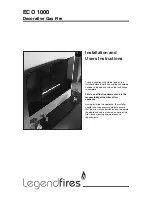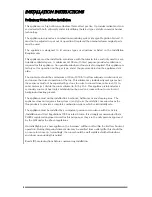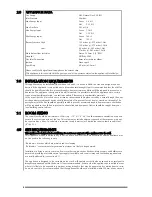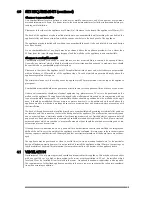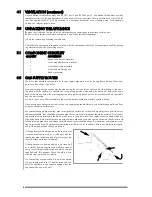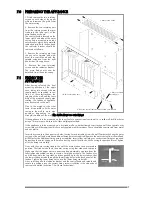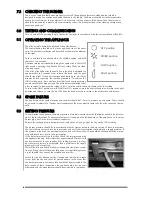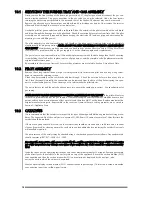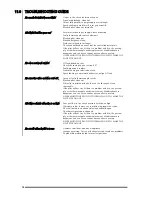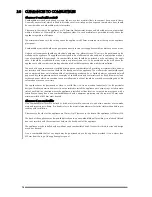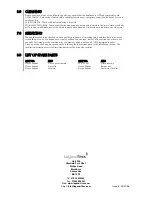
10
1100..22
1100..33
1100..11
SSEER
RV
VIIC
CIIN
NG
G TTH
HEE B
BU
UR
RN
NEER
R TTR
RA
AY
Y A
AN
ND
D G
GA
ASS A
ASSSSEEM
MB
BLLY
Y
Firstly, remove the front section of the frame (as per section 5.2), the glass panel, and disconnect the gas con-
nection inside appliance. The gas connections to the gas valve can now be released. Undo the four screws
retaining the burner support brackets to the base and rear of the firebox. The burner may now be removed.
Remove the pilot and main burner pipes and blow through to dislodge any debris. Now remove the injector
elbow and blow through to make sure it is entirely clear.
Unclip the pilot lint gauze and clean with a soft brush. Clean the exterior of the pilot assembly with a soft brush
and blow through the flame ports on the pilot head. Check the aeration holes are free from lint or dirt. The pilot
assembly can be removed if required by disconnecting the electrode HT lead, gas pipe and unscrewing the
mounting screws and lifting away.
The pilot assembly is a non-serviceable item and should not be taken apart. Aeration holes must be absolutely
clear internally for proper operation. N
NEEV
VEER
R M
MO
OD
DIIFFYY O
OR
R BBEEN
ND
D TTH
HEE TTH
HEER
RM
MO
OC
CO
OU
UPPLLEE TTO
O M
MA
AK
KEE TTH
HEE PPIILLO
OTT
SSTTA
AYY A
ALLIIG
GH
HTT. Modifications are dangerous and can have serious unseen effects on safety. If the pilot will not
stay lit there is a problem with dirt, the gas supply to it, or the thermocouple needs replacement.
The gas valve is a non-serviceable item. If this needs replacement, remove the data badge then the M5 securing
screw holding the valve bracket in place, remove all pipe unions, and the complete valve. Replacement must be
original manufacturers parts.
Re-assemble in the reverse of removal. Ensure setting pressures are as stated in Section 2; Appliance Data.
PPIILLO
OTT A
ASSSSEEM
MB
BLLY
Y
Remove the casing, internal firebox (as per servicing section), lint arrestor and pilot unit by using a long screw-
driver to remove the retaining screws.
Clean the pilot assembly with a soft brush and blow through. Check the aeration holes are free of any dirt or
lint. Clean thoroughly internally, the connection can be removed from the base of the pilot unit using two span-
ners to make cleaning easier. Do not damage or try to dismantle the pilot injector.
The unit is factory set and the only check necessary is to ensure the spark gap is correct. See specifications for
gas setting.
N
NEEV
VEER
R M
MO
OD
DIIFFYY O
OR
R BBEEN
ND
D TTH
HEE TTH
HEER
RM
MO
OC
CO
OU
UPPLLEE TTO
O M
MA
AK
KEE TTH
HEE PPIILLO
OTT SSTTA
AYY A
ALLIIG
GH
HTT. If the pilot will not stay
lit there is a problem with dirt, the gas supply, or the thermocouple needs replacement. Modifications are dan-
gerous and can have a serious unseen effect on safety and therefore MUST not be done. Replacements must be
original manufacturers parts. Re-assemble in the reverse of removal. Ensure setting pressures are as stated in
Section 2; Appliance Data.
C
CA
ATTA
ALLY
YSSTTSS
It is recommended that the catalysts are inspected for signs of damage and dirt during routine servicing proce-
dures. The expected life of the catalysts is in excess of 11,000 hours (10 years of normal use). After this time the
catalyst should be replaced.
If there are any deposits of dirt or soot on the catalysts they should be cleaned with a soft brush and a vacuum
cleaner. If removed for cleaning ensure the seals are in good condition before replacing the catalyst. New seals
will usually be required.
The performance of the catalyst may be checked using a combustion gas analyser as follows. Any analyser used
should conform to BS7927 : 1998 + A1 : 1999.
IIm
mppoorrttaanntt:: TThhee tteem
mppeerraattuurree ooff tthhee ggaasseess eem
mm
miitteedd bbyy tthhee ccaattaallyyttiicc ccoonnvveerrtteerrss iiss iinn eexxcceessss ooff 335500
oo
C
C.. M
Meeaassuurriinngg
ggaass ooff tthhiiss tteem
mppeerraattuurree m
maayy ddaam
maaggee ssoom
mee ttyyppeess ooff ggaass aannaallyysseerrss.. IIff iinn ddoouubbtt ccoonnssuulltt tthhee eeqquuiippm
meenntt m
maannuuffaacc-
ttuurreerr..
Ignite the fire as per the operating instructions, and run at maximum setting for 15 minutes. Position gas sample
probe directly over the catalyst via the outlet grille, on top of the appliance. Record the carbon dioxide (CO2)
concentration and then the carbon monoxide (CO) concentration as displayed by the analyser - also
noting the units in which the values are expressed.
Most analysers display carbon dioxide (CO2) concentrations in percentage (%) terms and carbon monoxide
concentration in parts per million (ppm) terms.
88

